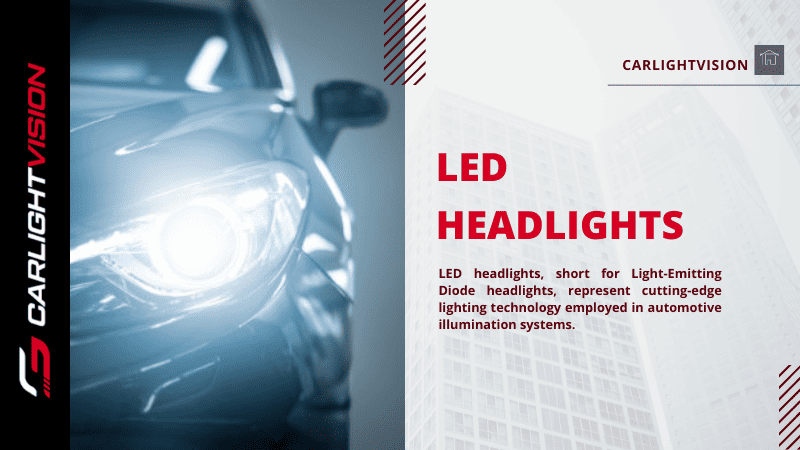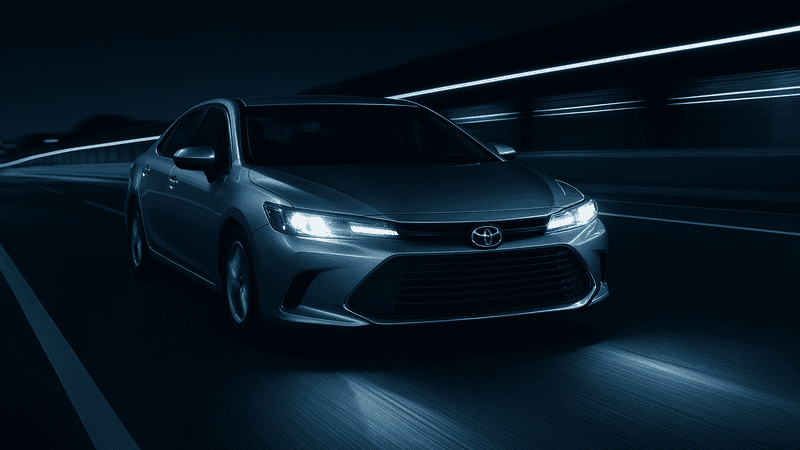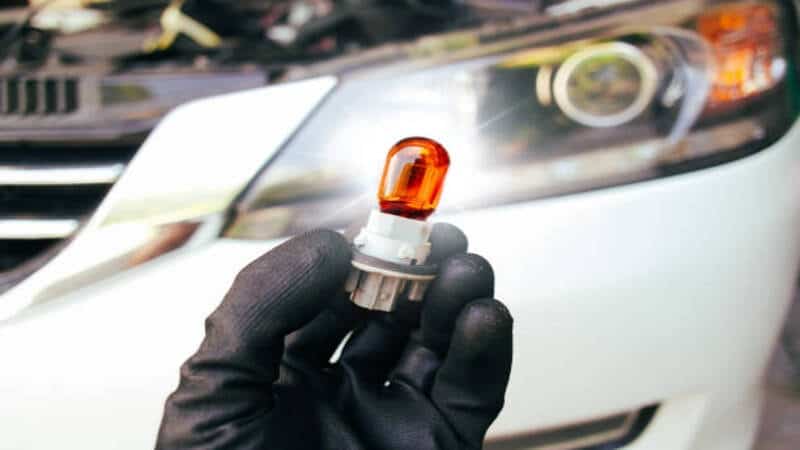LED lights offer greater efficiency than traditional halogen lights, reducing a car’s overall electrical strain. However, before making a purchase decision, it is important to understand how LED lights work, their benefits, and how to install and maintain them.
In this comprehensive guide, we will cover everything you need to know about LED headlights so you have a deeper grasp of this automotive lighting technology. Read on.
What Are LED Headlights?

LED headlights, short for Light-Emitting Diode headlights, represent cutting-edge lighting technology employed in automotive illumination systems.
LED headlights are quite different from conventional headlights, which depend on incandescent or halogen bulbs. LED headlights generate light using semiconductor diodes. This modern approach enhances efficiency and durability and aligns with the evolving standards in automotive lighting.
LED headlights are high-tech, meaning they can be configured into your desired size or shape. What’s more, they allow for adaptive headlight control, offering drivers better visibility than traditional lights.
LED headlights come with a series of individual LEDs. Each unit of an LED headlight consumes less energy, making them ideal for manufacturers conscious of energy consumption.
How Do LED Headlights Work?

Whether you are an automotive parts dealer or an automobile enthusiast planning on installing or retrofitting LED headlights, you should first understand how LED technology works and produces light in the headlights.
Below, we have detailed how the LED technology works in headlights:
Fundamentals Of LED Technology
LED (light-emitting diode) is a semiconductor with highly doped positive-negative junctions that emits colored light when it is forward-biased. It is encapsulated in a transparent cover.
When a diode is subjected to forward biasing, minority electrons flow directionally from the p-type region to the n-type region, and minority holes move from the n-type region to the p-type region.

At the junction boundary, there is an increase in the concentration of minority carriers. Subsequently, the excess minority carriers at the junction undergo recombination with the majority charge carriers.
During this recombination process, energy is released in the form of photons. In conventional diodes, this energy release manifests as heat. However, in light-emitting diodes (LEDs), the energy is emitted as photons, a phenomenon recognized as electroluminescence.
Electroluminescence is an optical and electrical phenomenon in which a material emits light in response to an electric current passing through it. As the forward voltage across the diode increases, the luminous intensity increases, resulting in maximum light output.
Light Production In LED Headlights
LED headlights produce light in quite a peculiar manner. They use tiny semiconductors to emit photons by allowing electricity to pass through them. As a result, bright white light is emitted to illuminate the area ahead. This light has a better reach than traditional halogen bulbs without being too overpowering.
LEDs require very little current to work. Therefore, the energy required from the battery to illuminate the headlights in a car is far less than xenons and halogens.
Comparing Headlight Technologies In Automobiles
Although most vehicles today have LED headlights, those from the past two decades have halogen headlights. The good news is that those halogen lights are replaceable.
But should you consider replacing the headlights? And should you replace them with LED or HID bulbs?
Below is a detailed comparison of the three main headlight technologies in automobiles:
1. Halogen Headlights
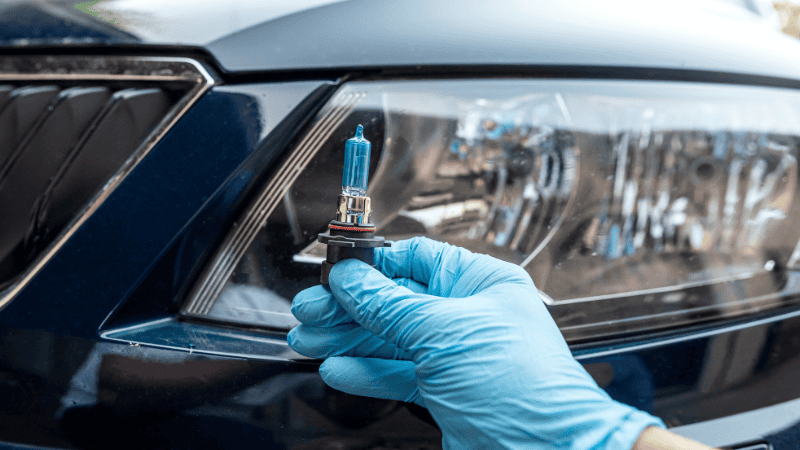
When it comes to different headlight technologies, halogen headlights are the most common type of lighting technology. They have been the go-to choice for automakers for the past two decades, mainly for their cost-effectiveness and easy replacement.
Sporting a tungsten element in halogen gas within a quartz envelope, these headlights emit both light and heat when you flip the switch. They are brighter and more enduring than your typical household incandescent bulbs and boast an average lifespan of 500 to 1,000 hours.
Halogen headlights cast a slightly more yellow glow and are often seen on older vehicles. If you need a replacement, they run between $10 and $25. However, they are not that energy efficient, and they emit high heat.
2. HID Headlights
HID (high-intensity discharge) headlights, also known as xenon headlights, shine brighter than halogens and have higher efficiency, whiteness, and brightness. These lights originated in the ‘90s on BMWs and are seen adorning luxury vehicles today.
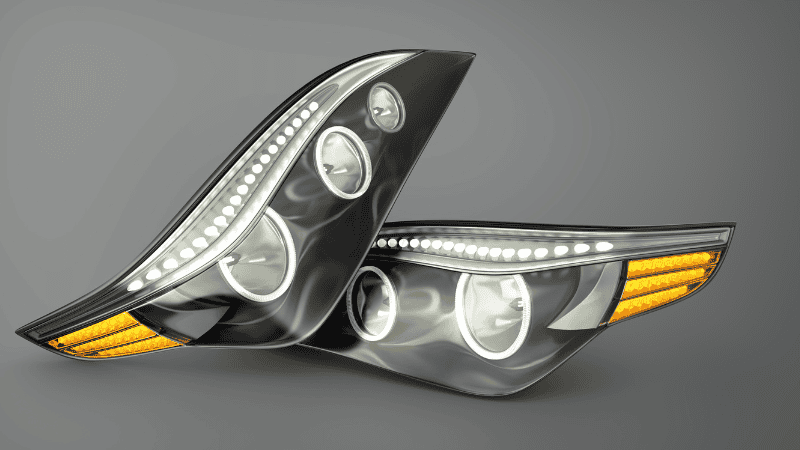
HID headlights illuminate by passing electricity through xenon gas to give a brilliant white glow. They are also ideal for daytime. However, they may take a moment to hit full brightness, which could be a bit dazzling for oncoming drivers.
The replacement costs are quite high. However, they compensate with a lifespan of up to 15,000 hours.
3. LED Headlights
Promoted by Lexus and Audi, LED headlights are widely popular today in modern cars and are being endorsed by many manufacturers for their efficiency and longevity. They are especially ideal for electric vehicles.
LED headlights emit light using semiconductors, delivering instant, bright white illumination. Versatile in color options, automakers often style them to create a signature look.
The IIHS recognizes LED headlamps for quality. However, they come at a price as replacements can soar over $300 each.
However, with a lifespan ranging from 25,000 to 45,000 hours, you might not have to worry about that anytime soon.
LED vs. Halogen vs. HID: Which Is Better?
| Parameters | Halogen | HID | LED |
|---|---|---|---|
| Source Component | Halogen gas | Xenon gas | Light emitting diodes |
| Brightness | Low | High | High |
| Longevity | 500-1,000 hours | 2000-8000 hours | 25,000-30,000 hours |
| Glare | Weak | Strong | Weak |
| Output Color | Warm White | Bright Blue-White | White |
| Direction | Omni-directional | Directional | Directional |
| Energy Efficiency | Low | Medium | High |
| Heat Emission | High | High | Low |
Halogen vs. HID vs. LED, which one takes the spotlight? While halogen headlights have been the go-to option for decades, we have recently seen HID and LED lights stepping into the market.
However, thanks to the recent developments in LED lighting technology, LEDs are taking over in the automotive industry. They are not only affordable but also offer a superior light source for vehicles. They are the best option available in the market in terms of energy efficiency, overall lifespan, brightness, heat emission, glare, and the light emitted.
Benefits Of LED Headlights
There are many reasons why LED headlights are better than halogen or HID lights. Below, we have listed all the benefits of LED headlights:
1. Lower Power Usage
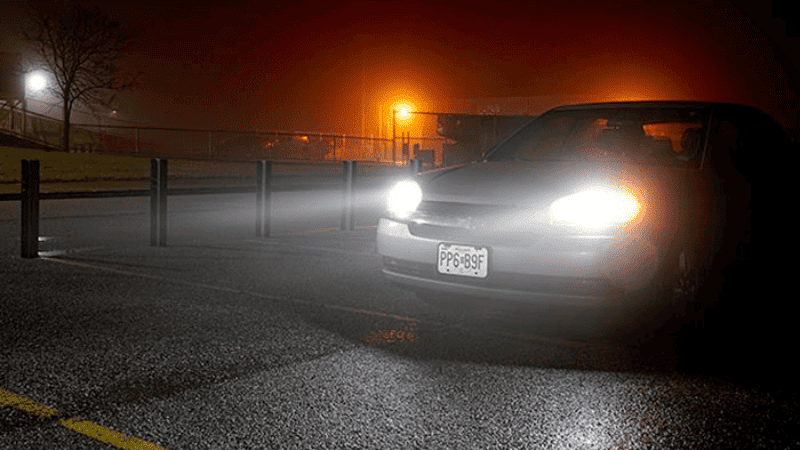
One of the main benefits of LED headlights is their minimal power usage, given their brightness. LED headlights boast 80% higher efficiency than traditional halogen bulbs.
As a result, they ease the load on a vehicle’s electrical system and also offer better fuel economy. This factor becomes particularly significant in electric vehicles (EVs), where every saved watt translates to more mileage.
2. More Versatile
LED bulbs exhibit more versatility than halogens. They can be configured in the shape and size of your choice, and their advanced technology allows for more adaptive control.
What’s more, certain LED designs use matrix technology to enable the selective deactivation of individual LEDs to prevent blinding oncoming vehicles. So you can enjoy higher brightness and visibility without blinding the oncoming drivers.
3. Improved Visibility
Visibility takes precedence, especially when navigating low-light environments or extreme conditions. In terms of brightness, LEDs outshine halogens and offer a more focused and stronger beam of light, such as our 360 LED headlight bulbs. As a result, drivers have a widened field of vision when driving at night, ensuring safety.

Additionally, LEDs emit a crisp white light that also offers better color rendering, allowing the drivers to make out objects and people more clearly. This way, they can avoid road hazards even in adverse weather conditions.
4. Better Lifespan
When it comes to projected lifespan, LED headlights surpass halogens, boasting a tenfold longer lifespan. They can offer uninterrupted lighting for 25,000 to 30,000 hours, which makes them ideal for people who travel long distances routinely.
However, the replacement costs can be higher as most manufacturers install sealed headlight assemblies in vehicles. So you’ll have to replace the entire unit.
5. Lower Carbon Footprint
Opting for LED headlights also contributes to a lower carbon footprint. Unlike xenon or halogen bulbs, LEDs consume significantly less energy.
Therefore, most vehicles today come equipped with LED headlights, a trend especially prominent in electric cars where minimizing power consumption is paramount.
Installation And Retrofitting Of LED Headlights
LED lights are standard on many cars these days. But for older vehicles, you will need to install them using simple installation kits. You can either choose to replace the entire unit using a kit or you can replace the headlights by retrofitting LED headlights.
If you are opting for an installation kit, the replacement process is pretty simple and takes just an hour. However, you have to be careful with the housing. They should be securely fitted so that there’s no water accumulation.
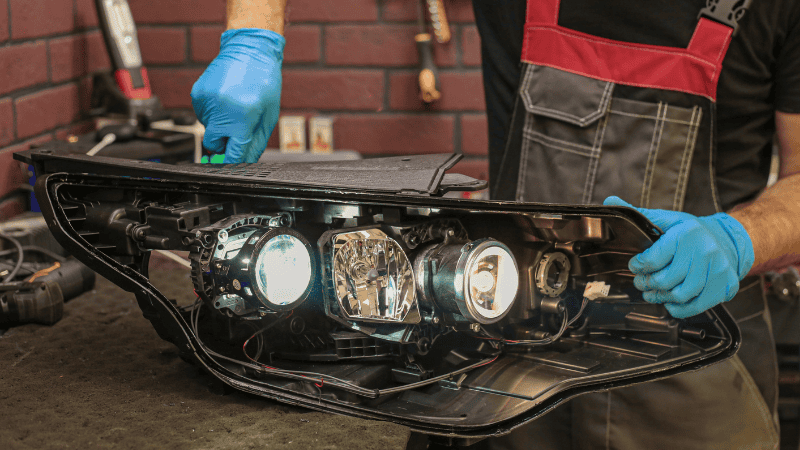
Also, you will need to pay special attention to the wiring, as LEDs require a rectified pulse current. You may also need various transformers or adapters, as highlighted by the seller.
If you are opting for the second option and only switching out the lamps instead or replacing the housing, you will need to retrofit the LEDs. These lights are typically compatible with integrated voltage systems. You can check out our 1:1 Plug and Play LED headlights for replacing the bulbs.
But the fan also requires a power source for those eyeing cooled LED headlights. It’s imperative to adhere to the manufacturer’s guidelines in the operating instructions to guarantee a seamless installation process.
Legal Considerations Before Installing LED Headlights
When retrofitting headlights, it’s crucial to adhere to a set of legal requirements, considering the significant safety implications associated with vehicle lighting.
The European guidelines categorize the car into three key sections:
- Front: All lighting devices in this section, except for fog lamps, are mandated to emit white light. Legal requirements include high-beam headlights, low-beam headlights, parking lights, reflectors, and reverse lights. Optionally, a clearance light, daytime running light, and fog lights can be incorporated.
- Side: Lights in this section must emit orange or yellow light. Mandatory components consist of a hazard warning light and direction indicators. Optionally, a side marker light and a reflector can be added.
- Rear: The color requirements for rear lights vary based on the type of light. Compulsory features include white reversing lights, yellow or orange flashing direction indicators, red tail lights, brake lights, and parking lights. Optionally, a red rear fog light and a red reflector can be integrated.
Notably, LED headlights do not have a specified maximum light intensity, providing flexibility in design. For comparison, classic H1 light bulbs are capped at 1150 lumens.
Tips For Maintaining The Performance Of LED Headlights
When it comes to nighttime driving, the headlights of a vehicle play the most important role in ensuring safe travel. Therefore, proper care and maintenance of LED headlights is extremely important.
Here are the most effective tips for maintaining the performance of LED headlights and making sure they don’t give up on you in times of need:
1. Clean Regularly
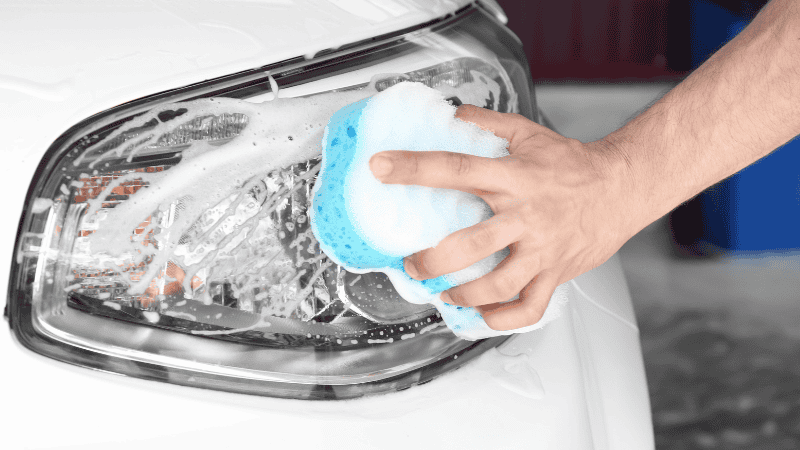
Just like you’d hit up a gas station to wipe off that windshield grime for better visibility, your headlights deserve some love, too. They might not scream for attention like a dirty windshield, but messy headlights? They sneakily mess with your visibility by making those LED headlight bulbs tougher to light up your path.
Grab a damp microfiber cloth and make it a weekly ritual to wipe down your headlights. This will keep the dust and dirt at bay, ensuring your headlights are on top of their game and keeping you cruising safely.
2. Test The Illumination
Now, let’s talk about solo headlights. If one of the headlights is not working properly while the other shines bright, you’ll have less illumination, and that’s not ideal.
It’s tricky to spot a blown headlight from the driver’s seat, so regular check-ins should be done. So park your car, flick on those headlights, and give it a walkaround. Make sure both headlights are working.
You can also pull up in front of a wall or garage door for a quick check. Double-checking means double safety. So, make sure to test the illumination of your headlights periodically.
3. Restore Yellowed And Clouded Headlights
Let’s talk yellowed headlights. If your headlights give off yellow or cloudy light, they dim the illumination. This can be due to the sunlight, which gives your headlights a yellowish tint. Smog and engine chemicals can also turn your headlights into a clouded mess.
Now, cloudy headlights are more than just a safety hazard – they can make it hard for you to resell your car. Anything aging your ride hurts its market value, and those yellowish headlights won’t give you a good resale value.
But hey, no need to panic! You can fix that by opting for headlight restoration kits. You can even swing by your local dealership and consider giving your ride a fresh pair of headlights.
4. Replace Both Bulbs Simultaneously
When one of the headlights starts acting up, it’s often just a matter of time before the other one follows suit. So don’t just replace one of them. Be proactive and replace both bulbs simultaneously.
Switching out both bulbs at once saves you from cruising with just one working light and keeps you road-ready.

5. Fix Misaligned Headlights
We already know how misaligned wheels can spell trouble on the road, but here’s a head-turner — headlights can also become misaligned, posing a safety hazard for the driver and the passengers.
Headlights are designed to stay synced. However, driving on bumps, potholes, and rough patches can misalign your headlights. Minor or major accidents can also displace them.
If your car’s beams are not aligned properly, they will not give you the necessary visibility. Once again, pull up in front of a wall or garage door for a quick check. If one of the beams is not synced with the other, it means that it is misaligned. Drive to a trusted mechanic and let them have a look.
Conclusion
LED car lights are far superior to traditional headlights in terms of performance, energy consumption, costs, maintenance, and lifespan, which is why most modern vehicles come with LED headlights installed from the factory today.
Now that you know what LED headlights are, their benefits, how they work, how to install and maintain them, and how they perform compared to traditional lights, you can easily deduce that they are the way to go for all vehicles.
Why Choose Carlightvision For LED Headlights?
Carlightvision‘s premium LED headlights are the most innovative in the market and come in various designs. We use the highest and most advanced technology to ensure safe driving by offering maximum visibility. All of our products meet CE standards and go through 7 inspections to ensure the highest quality. Contact us now to enlighten your vehicles!
